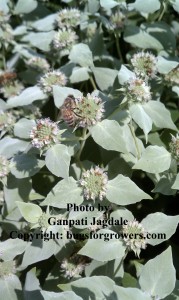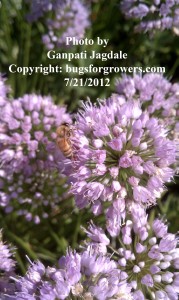Honeybees:
Honeybees are the insects that are members of the genus Aphis belonging to an insect order, Hymenoptera, family, Aphidae and class, Insecta. These bees are well known for collection (Fig. 1) and storage of honey in the combs constructed by bees out of wax. Since honeybees visit hundreds of different kinds beautiful flowers to collect honey and pollen (Fig. 2), they are also very good pollinators of different plant species including crops grown in organic vegetable gardens.


What is a beekeeping?
Beekeeping is the practice in which beekeepers who raise honey bee colonies for the production of honey for their personal use or commercial purpose (i.e. selling honey, bee wax, royal jelly etc). Beekeepers also use these bees to pollinate crops.
What are bee hives?
Bee hives are the enclosed structures that are generally made out of wood by beekeepers for raising colonies of honey bees for the production and storage of honey. The active honey bee hives are also placed in the fields or near to organic gardens to use bees for the pollination of crops.
What are small hive beetles?
Small hive beetles, Aethina tumida Murray (Coleoptera: Nitidulidae) are a destructive pest of honey bees, Aphis mellifera L. (Ellis and Delaplane, 2008). Although this insect pest is native to South Africa, its been around in North America since 1996 and responsible for causing serious economic damage to Apiculture (Beekeeping) industry in the United Sates.
How to identify small hive beetles?
Newly emerged young adults are light brown to red in color whereas mature adults are dark black in color and very active. Fully grown larvae (also called grubs) of small hive beetles are about 9-10 mm in length, 1.5- 2.0 mm wide and whitish in color. Pre-pupal stages are creamy white in color but mature pupae are dark brown in color. Both larval and adult stages found in active bee hives but pupal stages found about 3 feet away from bee hive and 10 – 20 cm deep in the soil.
Life cycle of small hive beetles
Under optimal climatic conditions, small hive beetles can complete their life cycle from egg to adult stage within 4-6 weeks and go through 5-6 generations in a year. Briefly, adult beetles immediately after emerging from pupae invade active honey bee colonies. They find honey bee hives by using their olfactory system to detect smells released from their favorite foods such as honey, pollen or honey bee alarm pheromones. After locating hives, beetles enter into the bee colony and hide from bee attacks in the cracks and crevices of colony boxes. In these cracks beetles mate and females lay over 1000 eggs in their life-time. Depending on the temperature, eggs hatch within 2-3 days after laying. Right after hatching from eggs, grubs enter into the comb and start feeding on honey, pollen and broods and matures in a couple of weeks. After maturation, larvae move into soil for pupation. Generally, pupal stage lasts for 3-4 weeks and and life cycle begins again when new adults emerged from pupae.
How do small hive beetle cause damage to honey bee hives?
Immediately after hatching from eggs, small hive beetle larvae begin feeding on honey, pollen collected by bees and especially brood. During this feeding process they destroy honey combs. In case of heavy infestation of small hive beetles, bees will leave the colony. In addition, both adults and larvae of small hive beetles carry yeast (Scientific name: Kodamaea ohmeri) on their bodies into the colony (Benda et al., 2008). This yeast grows on honey combs and that ferments all honey in the comb and the compounds secreted by this yeast also attracts beetles to bee hives. This fermented honey becomes useless as food for honey bees as well as for human consumption. Small hive beetles can also damage stored honey as described above.
What options are available for the control of small hive beetles?
Following options are available for beekeepers to control small hive beetles.
Chemical control: Although there are two chemical insecticides (including GuardStar and Checkmite) available to kill pupae and adults, respectively, extra care is needed as they may be toxic to humans, pets and the environment.
Biological Control: Entomopathogenic nematodes can be used as biological control agents against small hive beetles (see below). These nematodes are commercially available and not harmful to animals, honeybees and humans. They are easy to apply using water cans or any traditional sprayers. According to USDA scientist Dr. Shapiri-Ilan and his colleagues, Heterorhabditis indica nematodes have a potential to suppress the population of small hive beetles (Shapiro-Ilan et al., 2010). These researchers also reported that H. indica can cause over 78% mortality of small hive beetles.
What stages of small hive beetles can be targeted with entomopathogenic nematodes?
- Both mature larvae (grubs) and pupae are the best targets of entomopathogenic nematodes.
- When mature grubs of small hive beetle moves in the soil for pupation, entomopathogenic nematodes should be applied to the soil surface within 3 feet area around honey bee hives to target and kill both mature grubs and pupae.
When to apply nematodes
- As mature larvae of small beetles move away from bee hives and enter the soil to pupate, entomopathogenic nematodes should be applied on the soil surface.
- Since entomopathogenic nematodes are very sensitive to UV light, they will die within a minute or two when exposed to direct sunlight. Therefore, nematodes should be applied early in the morning or late in the evening to avoid exposure to UV light.
- Another advantage of applying entomopathogenic nematodes late in the evening around the bee hives is that these nematodes will be ready to attack the mature grubs/larvae of small hive beetles that generally move during night time to the soil to pupate.
- In addition, these moving grubs will be easily found by cruiser entomopathogenic nematode like Heterorhabditis indica to attack mature larvae that are already entered in the soil (at 10-20 cm depth) to pupae and those larvae already pupated.
How many nematodes should be applied to obtain good control of small hive beetles?
See our table for the right dosages of each entomopathogenic nematode species to be applied for optimum control of small hive beetles.
Read following papers for detailed information on effect of entomopathogenic nematodes on the small hive beetles.
Cabanillas, H.E. and Elzen, P.J. 2006. Infectivity of entomopathogenic nematodes (Steinernematidae and Heterorhabditidae) against the small hive beetle Aethina tumida (Coleoptera : Nitidulidae) . Journal of Apicultural Research 45: 49-50.
Ellis, J.D., Spiewok, S., Delaplane, K.S., Buchholz, S., Neumann, P. and Tedders, W.L. 2010. Susceptibility of Aethina tumida (Coleoptera: Nitidulidae) larvae and pupae to entomopathogenic nematodes. Journal of Economic Entomology. 103: 1-9.
Shapiro-Ilan, D.I., Morales-Ramos, J.A., Rojas, M.G. and Tedders, W.L. 2010. Effects of a novel entomopathogenic nematode-infected host formulation on cadaver integrity, nematode yield, and suppression of Diaprepes abbreviatus and Aethina tumida. Journal of Invertebrate Pathology. 103: 103-108.
